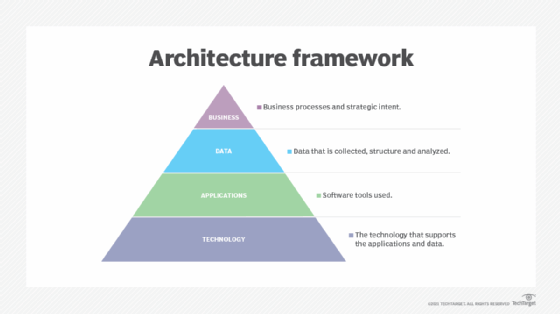enterprise architecture framework
An enterprise architecture framework (EA framework) is the collection of processes, templates and tools that are used to create an enterprise architecture (EA). An enterprise architecture is a conceptual blueprint, and the purpose of a framework is to help architects, designers and engineers understand how an organization's systems and assets are logically structured and connected.
An EA framework can be used to logically segment the architecture into layers, architectural views or domains. There are numerous types of enterprise architectures to choose from, and implementation may be different depending on which framework is chosen. The benefits of framework adoption typically become more apparent as the complexity and diversity of the architecture increases.
EA frameworks are important tools for companies that are conducting digital transformation initiatives. Enterprise modeling software tools such as Ardoq and SAP PowerDesigner can make implementation and management of a framework easier.
What components make up an enterprise architecture framework?
There are three basic components that make up the creation of an enterprise architecture framework: description, design method and organization.
- The description of an architecture should outline how the enterprise will be documented, as well as how the documentation can be viewed from multiple viewpoints.
- The design method should document what processes enterprise architects should follow when modeling the enterprise architecture. Processes can be organized into phases, which when combined, provide a holistic view of the enterprise architecture.
- The organization of an EA framework should be structured so that employee skill sets are coordinated and optimized for maximum output and efficiency. The framework should document skills gaps so training can be conducted.

How to implement a framework
To successfully implement an enterprise architecture framework, each enterprise stakeholder should be able to understand the architecture from their own viewpoint in the organization. Implementation should include the following steps:
- Identify how the architecture will be used and what level of detail will be required to understand dependencies.
- Review established frameworks and select the one that best fits the organization's culture and business goals.
- Ask lots of questions such as "What applications will be needed to create and support this framework?" and "What impact will change requests have on the rest of the architecture?"
- Identify what business rules should be created to act as constraints.
- Create a working model that provides transparency for critical information about the architecture.
- Integrate the architecture by linking the framework's components together.
Types of enterprise architecture frameworks
The type of EA framework used will differ depending on the chosen type of enterprise architecture. Popular frameworks include:
- The Zachman Framework for Enterprise Architecture -- this framework is often used to define and standardize what components and processes should be used to develop an IT architecture.
- The Open Group Architectural Framework (TOGAF) -- this popular framework is designed to help software engineers ensure development projects support business goals, maintain timelines, stay on budget and reduce errors.
- Open Agile Architecture (O-AA) -- this framework is used by self-directed work teams tasked with rolling out both Agile and digital transformation initiatives.
Other types of frameworks include:
- The European Space Agency Architectural Framework -- an important goal of this framework is to facilitate Systems of Systems (SoS) engineering for the internet of space.
- SAP Enterprise Architecture Framework -- an important goal of this framework is to function as an extension of TOGAF.
- ISO 19439 Framework -- an important goal of this framework is to enable consistency, convergence and interoperability for the various modeling methodologies an organization uses.
- U.S. Department of Defense Architecture Framework (DoDAF) -- an important goal of this framework is to ensure architecture artifacts, models and viewpoints can be shared and reused with common understanding.
- FDIC Enterprise Architecture Framework -- an important goal of this framework is to support the U.S. Federal Deposit Insurance Corporation's IT Governance Framework by defining and documenting roles and responsibilities for information security.
- Unified Architecture Framework (UAF) -- an important goal of this framework is to support software development initiatives in the military and government.
Choosing the right enterprise architecture framework
There are many different frameworks, and some will be a better fit than others when it comes to any one organization. When deciding which framework an organization should choose, the decision should be based on the type of organization and the direction it wishes to go in.
Questions that should be asked include:
- What type of business or organization will the framework be used for?
- Would a large, overarching structure that gives an organization step-by-step processes be preferred, or would a more flexible and agile framework fit better?
- Does the organization have a singular, focused goal and very few dependencies -- or does it have multiple goals with many dependencies?




